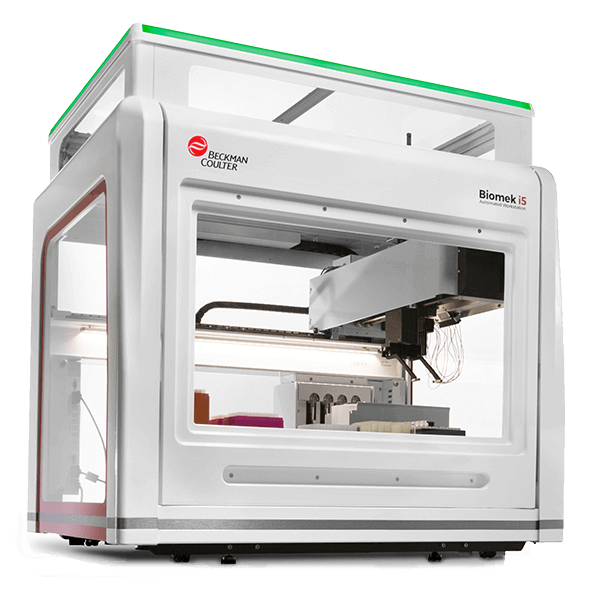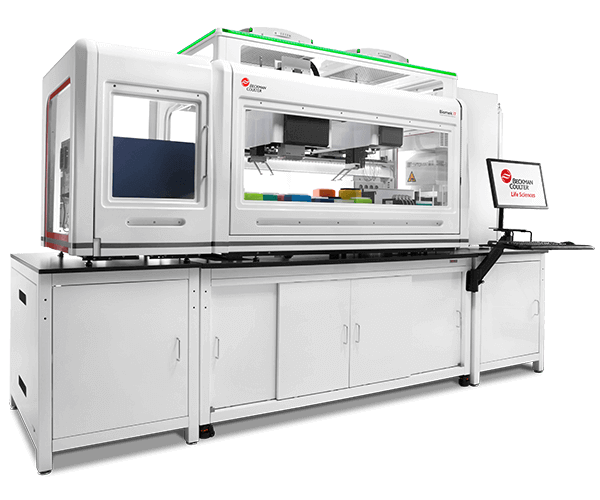Primary Screening
The goal of primary screening is to identify initial “hits”—often antibodies—as starting points for lead optimization. Typically, primary screening relies on assays that directly measure antibody-antigen binding, such as 96- or 384-well enzyme-linked immunosorbent assays (ELISAs) in high-throughput formats. In a typical ELISA, drug targets bound to ELISA plates bind to primary antibodies or antibody-expressing cells (potential hits), followed by detection antibodies. Automated ELISAs provide fast, high-sensitivity detection; they are a popular choice for primary screening assays.
Flow cytometry using fluorescence-activated cell sorting (FACS) is another common primary screening method. FACS allows researchers to quickly sort heterogeneous mixtures of cells into specific populations.
A typical FACS sample preparation workflow involves:
- Cell preparation
- Primary antibody addition
- Secondary antibody addition
- Multiple rounds of centrifugation and wash steps
Sample preparation automation significantly reduces time spent prior to FACS, enabling higher throughput.
Automated ELISAs
ELISAs screen heterogeneous mixtures of cells to determine which colony expresses a target antibody. The workflow for a typical ELISA involves numerous wash steps to remove unbound antibodies after antibody incubation, followed by incubation with a substrate for a colorimetric reaction.
Due to the large number of steps needed to carry out an ELISA procedure, it is a time-consuming process with potential for assay-to-assay variability. By automating the entire process, users reduce the likelihood of errors and increase the reliability of the generated data.
The Biomek NXP automated workstation automates ELISAs. By integrating the MultiWash™+ Microplate Washer and EMax® Plus Microplate Reader with a Biomek NXP Workstation, researchers can automate ELISA processing and analysis. This automated solution frees up resources while providing more reliable ELISA results.
Plate-Based Flow Cytometry
FACS is a specialized type of flow cytometry. It provides a high-throughput method for sorting a heterogeneous mixture of biological cells based on light scattering and fluorescent characteristics of each cell, which lends well to primary screening. However, cells need to be in a single-cell suspension, which creates problems with sample preparation. Automating flow cytometry using a plate-based format overcomes this issue. Additionally, plate-based assays enable a higher throughput.
CytoFLEX Flow Cytometers—small benchtop analyzers—integrated with Biomek i-Series Automated Workstations enable complete sample-processing automation and data acquisition.
Biomek i-Series workstations integrate and automate:
- Plating
- Drug treatment
- Dilution
- Trypsinization
- Resuspension
- Microplate centrifugation
For high-throughput applications, researchers can use SAMI EX software to schedule staining and analysis workflows, which ensures consistent analyses.
The Benefits of Automated Primary Screening
Performing primary screening with high-throughput, fully automated ELISA and FACS equipment prevents assay-to-assay variability and ensures reliable results. Biomek Workstations provide flexible automation solutions for ELISA and FACS applications; configurable deck layouts, numerous pipetting tools, and integration with other devices, such as plate readers and plate washers, help ensure fast, accurate primary screening.
Summary:
- Primary screening uses assays that directly measure antibody-antigen binding.
- Automated, high-throughput ELISAs or FACS are common primary screening methods.
- ELISAs can be automated to reduce errors and increase reliability of generated data.
- Plate-based FACS enables fast, simple, automated sample preparation and screening.
Featured Video: ELISA Automation on a Biomek i-Series
Watch: A Streamlined Approach to Automating ELISA
Products for Primary Screening

Biomek i5
(MC) Selective tip pipetting adds flexibility to screens using 96- to 1536-well plates
SAMI EX Software
Optimize scheduling to ensure consistent treatment across all plates

